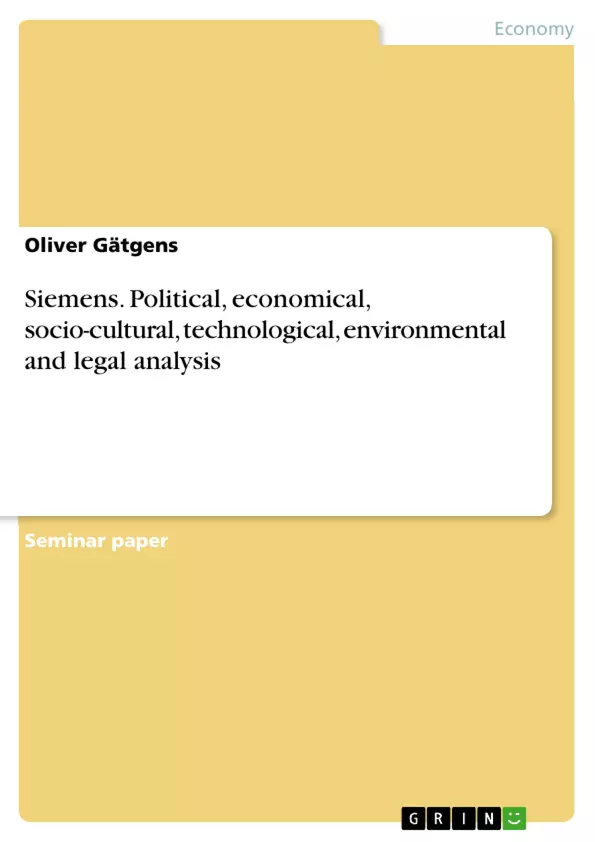Analyzing Siemens structure to give an overview about the political, economical, structural, technological, environmental and technological analysis.
Inhaltsverzeichnis (Table of Contents)
- Introduction
- International Business Environment
- Political
- Economical
- Socio-Cultural
- Technological
- Environmental
- Legal
- The Organizational Structure of Siemens
- Global or Local?
- Europe, C.I.S. and Africa
- Asia
- America
- Subsidiary Strategy
- Overview
- Siemens Venture Capital
- Industry Sector Investments
- Future Trends
- Overview
- Portfolio Strategy
- Climate Protection
- Corporate Citizenship
Zielsetzung und Themenschwerpunkte (Objectives and Key Themes)
This report aims to provide an overview of Siemens' industry sector, the largest and most profitable segment of the company's operations. The report focuses on the company's structure and its interaction with the international business environment, specifically considering political, economic, and other external factors impacting its operations.
- Siemens' organizational structure and its global reach.
- The impact of the global financial crisis on Siemens' industry sector.
- The influence of the political and economic environment in Germany on Siemens' operations.
- Siemens' response to a major corruption scandal.
- An analysis of Siemens' industry sector's performance and its contribution to the overall company revenue.
Zusammenfassung der Kapitel (Chapter Summaries)
Introduction: This chapter introduces Siemens, a large German electronics engineering company operating in the industry, energy, and healthcare sectors. It highlights the company's history, size (approximately 430,000 employees and €77.3 billion in revenue), and current ranking in Fortune magazine's Global 500. The report narrows its scope to focus on Siemens' industry sector, its largest and most profitable division, which includes industry automation, drive technologies, building technologies, OSRAM, industry solutions, and mobility. This sector generated €38.1 billion in revenue, contributing significantly to Siemens' overall income.
International Business Environment: Political: This section analyzes the political environment impacting Siemens, primarily focusing on Germany. It discusses the stability of the German political system following the recent elections, emphasizing the new coalition government's potential impact on employment regulations and minimum wage policies. A significant portion of this section addresses the major corruption scandal involving Siemens, the subsequent resignations of key executives (Klaus Kleinfeld and Heinrich von Pierer), and the resulting financial repercussions (approximately €2.9 billion in costs). The scandal's effect on Germany's ranking in the Transparency International report is also mentioned.
International Business Environment: Economical: This section examines the economic context surrounding Siemens' operations, particularly in Germany and the Eurozone. It details the impact of the global financial meltdown, showing a decline in economic growth rates for both Germany and the Eurozone, accompanied by a discussion on inflation and deflation. The changing value of the USD against the EURO and its implications are also addressed. The chapter further analyzes labor costs in Germany in comparison to the EU and Finland, highlighting expensive labor as a negative aspect. Finally, it outlines Germany's long-term economic prospects, emphasizing the need to balance the federal budget and stabilize the financial system.
Schlüsselwörter (Keywords)
Siemens, industry sector, international business environment, political risk, economic crisis, corruption scandal, organizational structure, Germany, Eurozone, Global 500, revenue, employment.
Siemens Industry Sector Report: Frequently Asked Questions
What is the purpose of this report?
This report provides a comprehensive overview of Siemens' industry sector, its largest and most profitable division. It analyzes the company's organizational structure, its global reach, and how it interacts with the international business environment, focusing on political, economic, and other external factors impacting its operations.
What are the key themes explored in the report?
Key themes include Siemens' organizational structure and global reach; the impact of the global financial crisis on its industry sector; the influence of the German political and economic environment; Siemens' response to a major corruption scandal; and an analysis of the industry sector's performance and its contribution to overall company revenue.
What aspects of the international business environment are examined?
The report examines the political, economic, socio-cultural, technological, environmental, and legal aspects of the international business environment impacting Siemens' operations. A significant focus is placed on the German and Eurozone contexts.
What is the scope of the report regarding Siemens' operations?
While Siemens operates in various sectors (industry, energy, healthcare), this report specifically focuses on its industry sector. This sector includes industry automation, drive technologies, building technologies, OSRAM, industry solutions, and mobility.
What is the significance of the Siemens corruption scandal?
The report details a major corruption scandal involving Siemens, highlighting the resulting costs (approximately €2.9 billion), the resignations of key executives, and the scandal's impact on Germany's ranking in the Transparency International report. The scandal's impact on the political and economic environment is also analyzed.
How does the report analyze the economic environment?
The economic analysis examines the impact of the global financial crisis on Siemens, focusing on the decline in economic growth rates in Germany and the Eurozone, inflation and deflation, changes in the USD/EURO exchange rate, and labor costs in Germany compared to the EU and Finland. Long-term economic prospects for Germany are also discussed.
What is the structure of the Siemens organization discussed in the report?
The report explores Siemens' organizational structure, including its global reach and its subsidiary strategy. It analyzes the organization's structure across different geographic regions (Europe, C.I.S., Africa, Asia, and America).
What are the future trends discussed concerning Siemens' industry sector?
Future trends discussed include Siemens' portfolio strategy, climate protection initiatives, and its commitment to corporate citizenship.
What are the key words associated with this report?
Key words include Siemens, industry sector, international business environment, political risk, economic crisis, corruption scandal, organizational structure, Germany, Eurozone, Global 500, revenue, and employment.
Where can I find chapter summaries?
The report provides summaries for the introduction and the sections on the International Business Environment (Political and Economical).
- Quote paper
- Oliver Gätgens (Author), 2009, Siemens. Political, economical, socio-cultural, technological, environmental and legal analysis, Munich, GRIN Verlag, https://www.grin.com/document/174925



